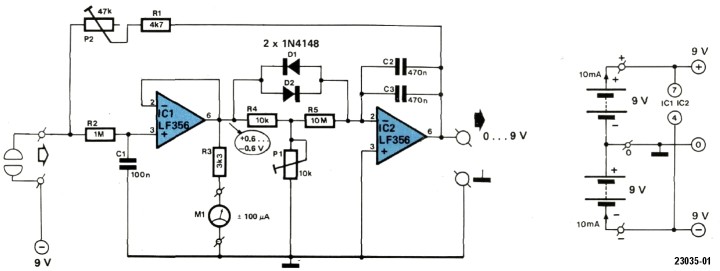Small Circuits Revival (42): Lie Detector
on
Lie Detector
Idea: Elektor Labs
Real lie detectors use various transducers attached to a person's body to measure parameters such as blood pressure, heart rate, breathing, skin resistance and temperature. The detector writes these values on a long strip of paper, and from this data, it can be deduced (allegedly) whether or not the person in question has answered questions truthfully. The use of lie detectors is controversial in many countries.
Here is a simple circuit that measures changes in skin resistance. You can use it in a playful way as a lie detector. An ordinary ohmmeter is not useful for our purpose. We don't want to measure the absolute value of the skin resistance, but its change. The circuit shown in Figure 1 makes it possible.

On the left side of the diagram, we see two electrodes (for example) on the back of a hand and on the corresponding forearm. On the 'lower' electrode, there is a negative voltage of 9 V. Through the skin (resistance) and R2 that voltage is applied to the extremely high impedance plus input of IC1. This input absorbs almost no current; the current flowing over or through the skin has to pass through P2 and R1 to IC2. This op-amp controls its output voltage in such a way that the 'top' electrode is always 0 V.
R5 and the parallel circuit of C2 and C3 provide a certain delay. Large voltage differences are quickly eliminated by both diodes. With small voltage differences, it can take up to 30 seconds before the voltage on the upper electrode is back to 0. In this way, we obtain a clear result of the rotary coil meter M1.
R1 and C2 form a low-pass filter to keep out any detected (hum) disturbances. The measuring instrument must be a specimen with the zero point in the middle of the scale.
About the adjustment we can be brief: attach both electrodes (how you make them is up to you) to the test subject's skin and connect a multimeter to the circuit's output (range: 10 VDC). Then turn P2 until the meter indicates a voltage of 2...6 V. (Wait until the reading is stable.) Thus, the detector is set to the skin type of the subject. When we now lightly press the electrodes, M1 should show a result. If that is okay, the detector is ready for use.
Warning: This circuit may only be powered by two 9-V batteries. Do not use a mains power supply under any circumstances!


Discussion (0 comments)